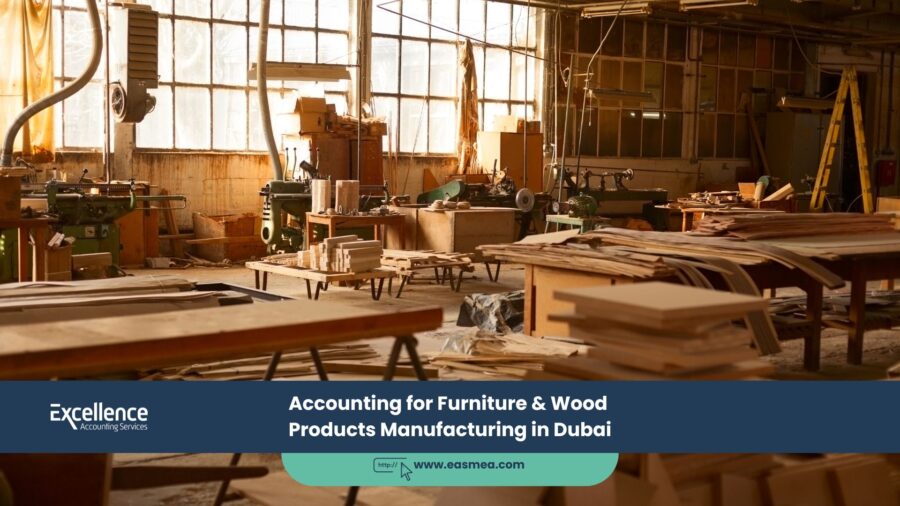Accounting for Furniture & Wood Products Manufacturing in Dubai, UAE: The 2025 Craftsman’s Guide to Profit
Dubai’s dynamic real estate market and its appreciation for high-quality interior design have created a thriving industry for furniture and wood products manufacturing. From bespoke cabinetry for luxury villas to large-scale production runs for commercial fit-outs, these businesses are the skilled artisans that shape the city’s interiors. While craftsmanship and design are the soul of the business, its long-term viability is carved from a solid block of disciplined, precise, and strategic financial management.
- Accounting for Furniture & Wood Products Manufacturing in Dubai, UAE: The 2025 Craftsman's Guide to Profit
- The Financial Anatomy of a Furniture Manufacturer
- Core Principles of Accounting for Furniture & Wood Products Manufacturing in Dubai, UAE
- Navigating Tax and Compliance in Dubai
- Frequently Asked Questions (FAQs)
- From Raw Wood to Revenue.
Accounting for a furniture manufacturing company in Dubai is a detailed process of tracking costs through every stage of production. It involves managing a diverse inventory of raw materials like timber and hardware, calculating the exact cost of every piece produced, and correctly allocating the significant overheads of a workshop or factory. Without a robust accounting framework, even a workshop full of beautiful creations can see its profits sanded away by un-costed materials, inefficient labor, and poor pricing.
This definitive guide provides a strategic blueprint for Accounting for Furniture & Wood Products Manufacturing in Dubai, UAE. We will explore the critical financial practices for the sector, from the fundamentals of job order costing for custom pieces to the complexities of allocating workshop overheads. We will also provide clarity on the application of VAT and the new UAE Corporate Tax to manufacturing operations, ensuring your business is both compliant and profitable.
Whether you are a master craftsman creating bespoke furniture or a large factory producing joinery products, this guide will equip you with the financial knowledge to manage your operations with precision. We will cover industry best practices, essential financial controls, and the reporting that builds confidence with clients, designers, and financial institutions.
Key Takeaways
- Job Order Costing is Essential: The core of the business is calculating the precise cost of every single piece or project, including direct materials (wood, hardware), direct labor, and a share of workshop overheads.
- Meticulous Inventory Management: You must track your inventory of raw materials (wood, veneers, finishes), work-in-progress, and finished goods to control costs and manage your assets effectively.
- Workshop Overheads Must Be Allocated: All indirect workshop costs (rent, utilities, supervisor salaries, machine depreciation) must be systematically allocated to the products being made to determine their true cost.
- Gross Margin Drives Profitability: Your gross profit (Sales Revenue minus the full Cost of Goods Sold) is the key indicator of your production efficiency and pricing accuracy.
- VAT and Corporate Tax Compliance: Manufactured furniture is subject to 5% VAT. Understanding this, along with the 9% Corporate Tax on your profits, is a legal necessity for your business.
The Financial Anatomy of a Furniture Manufacturer
A furniture and wood products manufacturer is a classic production business. The model is built on transforming raw materials into high-value finished goods through skilled labor and specialized machinery. Financial success depends on producing quality items efficiently, controlling costs at every step, and pricing products to reflect their true cost and craftsmanship. The entire financial system must be designed to track the journey of cost from raw timber to finished table.
Operating in the UAE means being part of a market that values both quality and timely delivery. It also means adhering to safety and environmental regulations, particularly concerning wood sourcing and waste disposal. These compliance costs are a necessary part of your operational budget.
Core Principles of Accounting for Furniture & Wood Products Manufacturing in Dubai, UAE
The fundamental principle of accounting for furniture & wood products manufacturing in Dubai, UAE, is the accurate tracking of costs through the production cycle using a job order costing system. Because many pieces are custom or made in small batches, you must know the specific cost of each job to ensure it is profitable.
The Foundation: Job Order Costing for Custom Pieces
You cannot set a profitable price for a custom dining table if you do not know exactly what it cost to make. A job cost sheet (or its digital equivalent in your accounting software) must be created for every single project. This sheet becomes the central point for accumulating all the direct costs associated with that specific job.
The three key cost components to track for each job are:
- Direct Materials: The cost of the specific wood, veneer, hardware, finishes, and other materials that are physically part of the finished piece.
- Direct Labor: The wages of the craftsmen, carpenters, and machine operators for the time they spent working directly on that job.
- Workshop Overheads: A fair share of all the other costs of running the workshop, which are allocated to the job based on a predetermined rate.
In woodworking, the beauty is in the grain, but the profit is in the costing sheet. Every detail must be accounted for.
By totaling these three costs, you arrive at the total cost of the job. Comparing this to the client’s price gives you the gross profit. This data is the most powerful tool for quoting future projects accurately and understanding which types of work are most profitable for your business. A professional bookkeeping service is essential for setting up this detailed cost tracking.
A Closer Look at Accounting for Furniture & Wood Products Manufacturing in Dubai, UAE
Profitability in the competitive furniture market is built on a foundation of efficiency and waste reduction. This requires a detailed approach to managing your raw material inventory and a systematic way of allocating your workshop’s indirect costs.
Managing Raw Material Inventory
Your inventory of wood, veneers, hardware, and finishes is a major asset that requires careful management. You need an inventory system that can track not just the type of wood, but also its grade, thickness, and cost. When wood is taken from the storeroom for a specific job, its cost must be transferred from the “Raw Materials Inventory” account to the “Work-in-Progress” account for that job. This is crucial for accurate job costing.
Accounting for wood offcuts and wastage is also important. A certain amount of waste is normal in woodworking. The cost of this “normal spoilage” should be treated as a factory overhead cost and allocated across all jobs. However, if there is “abnormal” spoilage (e.g., a large, expensive piece of wood is ruined by an error), this cost should be expensed immediately as a loss to highlight the production issue.
| Inventory Stage | Description | Accounting Account |
|---|---|---|
| Raw Materials | Wood, hardware, finishes, etc., in storage. | Raw Materials Inventory (Asset) |
| Work-in-Progress (WIP) | The accumulated cost of materials, labor, and overhead for jobs currently being built. | WIP Inventory (Asset) |
| Finished Goods | The full cost of completed furniture waiting for delivery or sale. | Finished Goods Inventory (Asset) |
Allocating Workshop Overheads
This is a critical step for accurate costing. Workshop overheads are all the indirect costs of running your production facility. To get the true cost of a piece of furniture, you must allocate a fair share of these overheads to it. These costs include:
- Indirect Materials (glue, sandpaper, cleaning supplies)
- Indirect Labor (workshop supervisor, maintenance staff)
- Facility Costs (workshop rent, electricity, insurance)
- Equipment Costs (depreciation of saws, sanders, CNC machines)
The standard method is to use a Predetermined Overhead Rate. You estimate your total workshop overheads for the year and divide this by an allocation base, such as the total estimated direct labor hours or machine hours. This gives you an overhead rate (e.g., AED 50 per direct labor hour). If a custom cabinet takes 20 hours of direct labor to build, you would “apply” AED 1,000 (20 hours * AED 50/hour) of workshop overhead to its job cost sheet.
Navigating Tax and Compliance in Dubai
A professional furniture manufacturer in Dubai must be fully compliant with the UAE’s tax and customs regulations. For the most authoritative guidance, you should always refer to the official website of the Federal Tax Authority (FTA).
VAT on Manufactured Furniture
The sale of furniture and wood products within the UAE is subject to the standard 5% rate of VAT. When you import raw materials like timber, you will pay 5% VAT at customs, which you can then reclaim as input VAT. When you export your finished furniture to a customer outside the UAE, this is a zero-rated supply, provided you retain all official export documentation as proof. A meticulous system for VAT accounting is crucial.
Corporate Tax for Manufacturers
Your manufacturing company will be subject to the 9% UAE Corporate Tax on its annual taxable profits exceeding AED 375,000. Your taxable profit is your gross profit (Sales minus Cost of Goods Sold) less your operating expenses. The accuracy of your job costing and overhead allocation will have a direct and significant impact on your taxable profit. Maintaining complete records for every transaction is mandatory. Professional corporate tax services are vital for ensuring compliance.
What Excellence Accounting Services Can Offer
At Excellence Accounting Services (EAS), we have deep expertise in manufacturing and production accounting. We understand the unique financial challenges of the furniture and woodworking industry, from the complexities of job costing to the management of factory overheads. We offer specialized accounting services to provide the financial control and strategic insight your workshop needs.
Our specialized offerings for furniture manufacturers include:
- Job Order Costing System Implementation: We help you design and implement a robust system to track direct materials, direct labor, and workshop overheads to calculate accurate per-unit costs.
- Inventory Management Accounting: We can help you set up systems to manage your raw materials, WIP, and finished goods inventory, ensuring accurate valuation and control.
- Fixed Asset and Depreciation Management: We manage the accounting for your machinery, including calculating depreciation and advising on the capitalization of major repairs.
- VAT and Corporate Tax Compliance: Our tax experts will manage all your FTA filings, ensuring you are fully compliant with the rules for manufacturers.
- Virtual CFO Services: Get high-level strategic guidance on pricing, margin analysis, and capital expenditure decisions. For more details, see our Virtual CFO services.
By partnering with EAS, you gain a financial team that understands the craft of your industry. We handle the financial complexity so you can focus on creating exceptional products.
Frequently Asked Questions (FAQs)
The cost of the wood allocated to the job should be based on the amount of wood issued from the storeroom for that specific job, not just the wood that ends up in the final piece. The cost of “normal” waste (like sawdust and small offcuts) is typically included in your factory overhead rate and allocated to all jobs. This way, the cost of unavoidable waste is shared proportionally. However, if a large piece of expensive wood is ruined due to an error (abnormal spoilage), its cost should be expensed as a loss, not added to the cost of the job.
A Direct Material is a raw material that becomes a significant, easily traceable part of the finished product. For a wooden table, this is the wood itself and perhaps the specific hardware like handles. An Indirect Material is a consumable used in the production process but is not a significant part of the final product. Examples include sandpaper, glue, screws, and cleaning solvents. The cost of these indirect materials is included in your factory overhead calculation.
A CNC machine is a major fixed asset. Its cost is capitalized on your balance sheet. You then “depreciate” the machine over its estimated useful life. The annual depreciation expense is a factory overhead cost. It should be included in the calculation of your machine hour rate for the CNC machine and allocated to the specific jobs that use the machine. This ensures the high cost of the machine is factored into the price of the products it helps to create.
Customs duties are not treated as a separate operating expense. They are a direct cost of acquiring your raw materials. The amount of customs duty you pay should be added to the purchase price of the wood to calculate its total “landed cost.” This total cost is what is recorded in your “Raw Materials Inventory” account. The cost is then expensed as part of the Cost of Goods Sold only when the finished furniture is sold.
Yes. Your sale is to the client in the UAE. The service of manufacturing and the sale of the goods takes place in the UAE. Therefore, you must charge 5% VAT on your invoice to the client. What the client does with the furniture afterward (i.e., exporting it) does not change the nature of your local sale to them. They may be able to reclaim the VAT through specific business or tourist refund schemes, but you are required to charge it.
When you receive an advance deposit from a client, you have not yet earned the revenue. The cash received should be recorded on your balance sheet as a liability, under an account like “Customer Deposits” or “Deferred Revenue.” You would typically recognize the revenue when the furniture is completed and delivered to the client. At that point, you would reduce the liability and record the full sale on your income statement.
WIP inventory represents the accumulated cost of jobs that are currently on your workshop floor but are not yet complete. It includes the cost of the direct materials that have been issued to the job, the direct labor hours that have been worked on it, and the factory overhead that has been allocated to it so far. It is a key asset on your balance sheet that shows the value tied up in your production process.
This is a common working capital issue for manufacturers. Your cash is often tied up in three places: Raw Materials Inventory (wood you’ve paid for but haven’t used), Work-in-Progress (jobs you’re building but haven’t finished), and Accounts Receivable (finished jobs you’ve delivered but haven’t been paid for yet). The time it takes to convert a cash payment for raw materials into a cash receipt from a customer can be very long. Managing this “cash conversion cycle” through faster production and quicker client payments is key.
Your historical job cost data is your most powerful quoting tool. After you have accurately costed dozens of projects, you can build a reliable database. When a client asks for a quote for a new custom piece, you can find similar jobs you’ve done in the past and see exactly what they cost you in terms of material and labor hours. This allows you to create a new quote based on real data, not guesswork, ensuring your pricing is both competitive and profitable.
An independent audit provides credibility. If you are supplying furniture for large-scale projects (like hotels or property developments), the main contractor or developer may require you to provide audited financial statements as part of their supplier vetting process. If you need a loan from a bank to purchase new machinery or expand your workshop, they will demand audited financials. An audit provides independent assurance that your financial statements, particularly your complex inventory and cost accounting, are accurate and reliable.
Conclusion: Crafting a Profitable Manufacturing Business
In the world of furniture and wood products manufacturing, the beauty of the final piece is a result of skill, patience, and an eye for detail. The financial success of the business that creates it requires the very same qualities. A disciplined and detailed accounting system is the essential framework that supports the entire production process, ensuring that craftsmanship translates into sustainable profit.
By mastering the science of job order costing, maintaining rigorous control over your inventory and overheads, and navigating the UAE’s tax landscape with expertise, you build a business that is as solid as the timber you use. This financial clarity empowers you to price your work with confidence, manage your workshop with efficiency, and build a lasting reputation for quality and professionalism in Dubai’s dynamic market.
From Raw Wood to Revenue.
Let Excellence Accounting Services provide the specialized financial management and industry insight your furniture and joinery workshop needs to succeed in the UAE.




